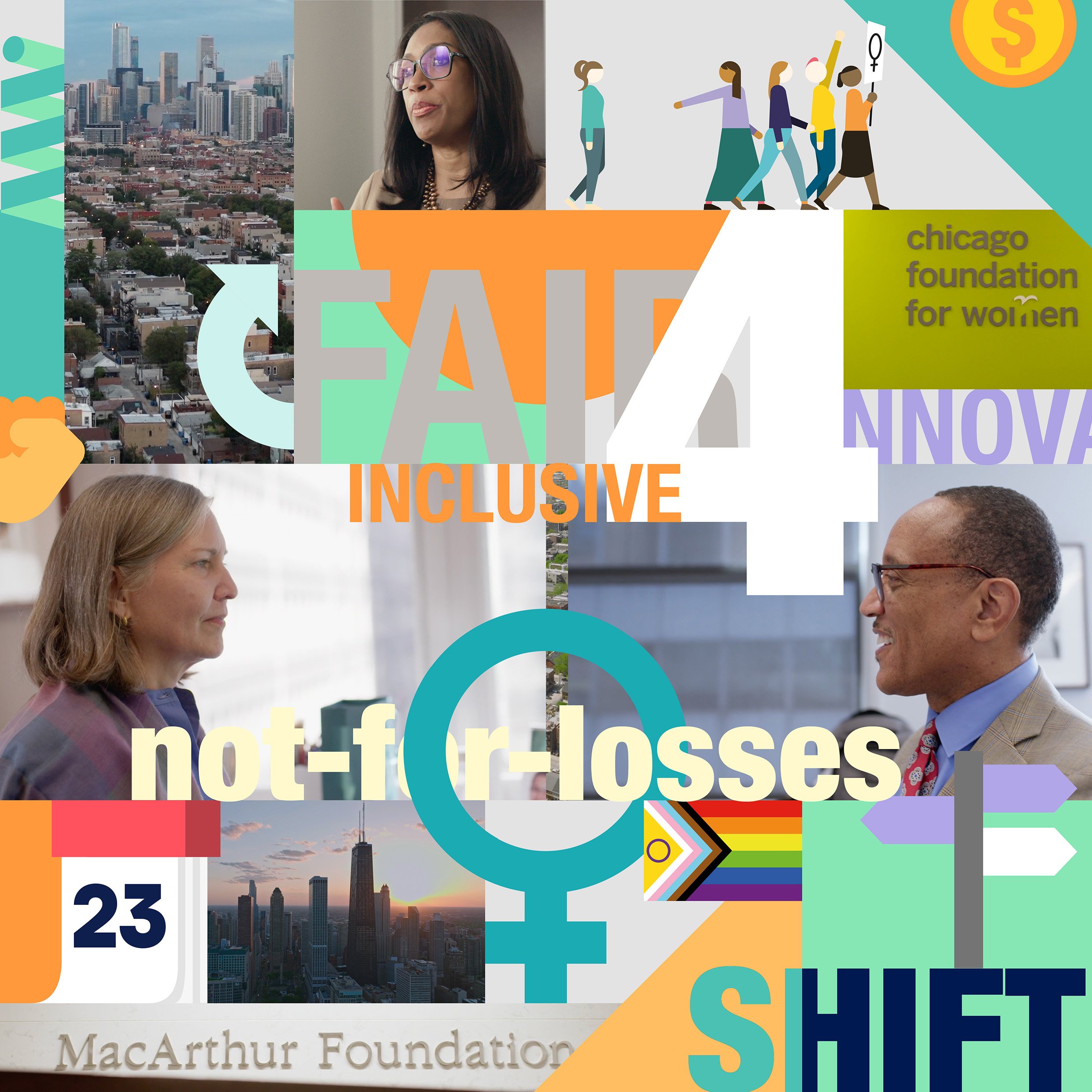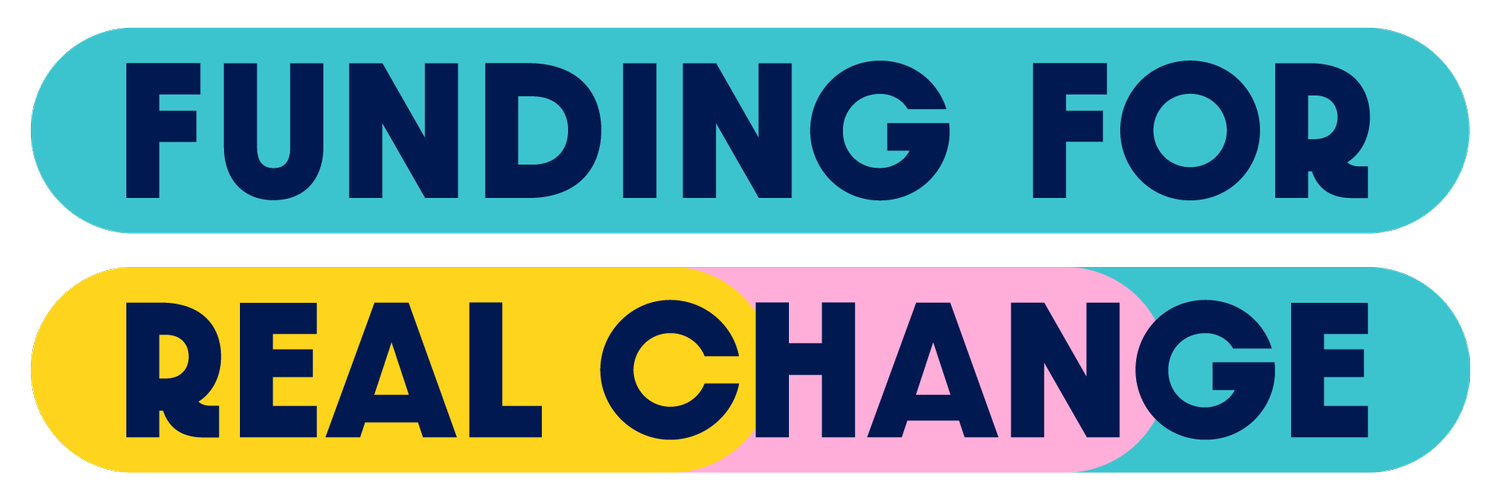Chicago Foundation For Women + MacArthur Foundation
Video by Paul Johannessen
Learn more about:
MacArthur Foundation
Learn more about:
CFW

The MacArthur Foundation: Embracing core values
An early innovator
For MacArthur, a key takeaway from the pilot was that this process – although illuminating and effective – was prohibitively time-consuming and expensive. Each consultation lasted between eight to 12 weeks, costing between $16,000 to $31,000. Replication would not be feasible given the scale of its grantmaking operations, disbursing hundreds of grants each year totaling upwards of $300 million.
Undeterred and committed to improving its then-policy of capping indirect costs at 15 percent, the foundation pivoted to a new approach.
What began as a presidential initiative evolved into an expansive, participatory process imbued with MacArthur’s core values: creativity; diversity, equity, and inclusion; empathy; integrity; and learning.
Kenneth Jones, MacArthur Foundation, Chief Operating Officer and Chief Equity Officer
The MacArthur Foundation was one of the original members of the ambitious five-funder collaborative, which later evolved into the Funders for Real Cost, Real Change Collaborative, that came together in 2016 to gather empirical evidence of how insufficient indirect cost coverage in project grants is harmful to grantees and to explore solutions. The presidents of these peer foundations initiated the True Cost Project pilot in 2018, undertaken by the Bridgespan Group, which entailed one-on-one consultations with nonprofit organizations to verify their “true” indirect cost rates.
“We try in everything we do to lead with our values, internally and externally...having a consistent value-driven culture that crosscuts our grantmaking, our business practices, and our organizational practices.”
Stephanie Platz, Macarthur Foundation, Managing Director of Programs
Policy development: Complex challenges, creative solutions
No stranger to developing and deploying creative solutions to complex challenges, the foundation commissioned additional research to further explore the link between indirect costs and organizational financial health. Analysis of IRS Form 990 data from 137,000 U.S. nonprofits revealed that the “benchmark” rate associated with financially healthier organizations was 29%
With Board and leadership buy-in, this key finding became the cornerstone of deliberative dialogue held at all levels of to construct a new indirect cost policy, facilitate organizational “culture change,” and gain and maintain broad support for more flexible, empathetic grantmaking practices. Multiple drafts of the policy were written, informed by input from both internal and external stakeholders. To ensure there were diverse voices in the room, focus groups were held with staff from numerous departments and grantees with different organization types and budget sizes.
“We couldn't use a few examples and say we had the answer. We needed enough data points, enough diversity in the grantee population, to ensure that where we ended would make sense... we're a data-driven organization. The data spoke loudly.”
Kenneth Jones, Macarthur Foundation, COO and Chief Equity Officer
Learning and leading: “This isn’t our end point”
MacArthur is known for its evaluation excellence and deep commitment to learning. In 2021, the foundation conducted interviews with grantees and staff to understand the initial impacts of the new policy.
“One shift we’ve seen internally – which cannot be attributed only to the indirect cost rate change and is also a product of our times and response to the pandemic, racial reckoning, and critiques of philanthropy – is the increased use of general operating and flexible support.” D0F7E3
Elizabeth Powley, MacArthur Foundation, Director of Grants Management
Grantees expressed, for example, that the higher rate enabled them to fill critical funding gaps from grants with lower indirect cost rates; subsidize under-funded activities; cover non-program staff expenses; and increase investments in fundraising, grants management, and administrative functions.
The foundation continues to examine and holistically support the health of its nonprofit partners. For example, new research is underway to better understand grantee financial health; it will inform any potential evolution of the indirect cost policy.
Grantmaking procedures are being streamlined to reduce burdens on grantees.
General operating support grants have doubled since 2019.
Grantees participate in convenings to build relationships with one another through peer learning and knowledge exchange. Along the way, MacArthur is sharing its journey to stimulate sector-wide change.
As the philanthropic sector evolves, the foundation is not simply moving with the tide but rather playing an active role in dismantling existing structures that disadvantage and do harm.
This is driven in part by its Just Imperative, which calls upon it to lead with justice, interrogate its own decisions and actions, and create conditions for people to have equitable access to opportunities and thrive.
The new policy: consistent, fair, and flexible
Under the policy launched on January 1, 2020, all U.S.-based non-profits and organizations abroad with 501(c)(3)s equivalency determinations receive an indirect cost rate of 29 percent in project grants. It is noteworthy that a half-step measure – between 15 and 29 percent – was initially proposed; however, the foundation decided to proceed with the full increase based on staff feedback.
The flat rate approach was chosen because of the consistency and fairness it brings, eliminating the burden on grantees to negotiate and on program officers to make difficult judgements. The policy also enables organizations that prefer to take a rate to do so and use the remaining funds in any way they choose. This flexibility supports their agency and reflects MacArthur’s commitment to trusting its nonprofit partners.
Implementing grantee-centered change
Change management is an ongoing process that requires consistent communication, transparency, and affirmation. As such, in advance of the policy launch, staff were sensitized to and trained in how to implement the new directive, including how to communicate it to grantees and address any concerns. A press release was issued, explanatory emails were sent, and the policy and FAQs were published on MacArthur’s website, including budget examples and other resources. The foundation also provided technical assistance to grantees to ensure they understood it, including through interactive webinars.
The rollout for domestic grantmaking was consistent, a key enabler of which is MacArthur’s centralized grants management department. Program officers and grants management staff sit together and can quality check from both vantage points. For international grantmaking, as noted above, organizations with equivalency determinations receive the flat rate. Those without it are treated on a case-by-case basis. The foundation is currently exploring how it can apply the policy more evenly and equitably to non-U.S. grantees, taking into account context-specific challenges related to different tax and legal constraints.

The Chicago Foundation for Women: The power of women’s funds
Leaving no one behind
As part of its commitment to advancing racial equity and building a more inclusive Chicago, the MacArthur Foundation’s support to the Chicago Foundation for Women (CFW) undoubtedly has multiplier effects throughout and beyond the city. CFW envisions a future in which all women, girls, and trans and nonbinary people can thrive in safe, just, and healthy communities. To that end, it mobilizes and provides financial and nonfinancial resources to local organizations in support of three mutually supportive, co-constituting issues: access to healthcare and health information, freedom from gender-based violence, and economic security and upward mobility. CFW has an intersectional and inclusive approach that acknowledges how people can experience compounding forms of oppression based on gender, race, and other aspects of their identity. As such, it focuses on uplifting communities of color in the Chicago area in which there has been historical disinvestment.
Not-for-profit and not-for-losses
CFW receives an indirect cost rate of 29 percent rate in project grants from MacArthur, which is much closer to its institutional needs of approximately 33 percent than other grants it has secured.
The majority of CFW’s funders still provide the sector-wide status quo of 15 to 20 percent, which evidence has shown is insufficient – particularly for organizations led by women, girls, LGBTQ people, and people of color.
This broad resistance to change reflects persistent power imbalances and lack of trust in philanthropy.
“We're not-for-profit but we're also not for losses, which is fundamental. I think the way the system is set up, it expects nonprofits, grant recipients, to take losses all the time and that's not fair.”
Felicia Davis Blakely, CFW, President & CEO
Like many women’s funds around the world, CFW is not fully endowed. As an “intermediary” – an organization that regrants funds from larger foundations and corporations – restricted funding creates additional pressure to raise unrestricted dollars and fill critical funding gaps to remain financially viable.
This, in turn, facilitates its uninterrupted provision of general operating support and crucial capacity building to grantees.
As CEO and President of CFW, Felicia Davis Blakely has her sights set on the future but is guided by lingering historical injustices.
She urges funders to understand how the evolution of women’s participation in philanthropy, which remains predominantly male and white, and the under-resourcing of feminist funds are inextricably linked to the history of women’s rights.
In the recent past, women in the U.S. faced substantial barriers to controlling their own financial resources, let alone leveraging them for philanthropic giving.
For example, they faced immense discrimination and largely could not apply for a credit card or loan without a male co-signer until the Fair Credit Opportunity Act in 1974, less than fifty years ago.
In many countries around the world, significantly less progress has been made. Like CFW, many women’s funds in the U.S. sprang to life in the ‘70s and ‘80s as frontline aid to feminist movements building their collective power to effect social change.
Why women’s funds?
One of CFW’s greatest barriers to funding is having to constantly justify its own existence and explain the unique position, knowledge, and expertise it brings as a women’s fund, particularly one with an expansive mission to also supports trans and nonbinary people.
So, what is its added value?
“Our theory of change is if you actually holistically support these organizations and the communities – the leaders and the organizations themselves – it actually increases the efficacy of those organizations.”
Felicia Davis Blakely, CFW, President & CEO
Who and what does CFW support?
As mentioned above, women’s funds are vital lifelines for small but mighty nonprofits. Women’s and girls’ organizations receive less than two percent of overall philanthropic giving in the U.S. One half of one percent goes to women and girls of color. Foundation grants awarded in support of LGBTQ issues are fewer still, and decreasing. The socioeconomic devastation of the pandemic that has disproportionately affected women, girls, and gender minorities, particularly people of color, and the rolling back of women’s and LGBTQ rights with the rise of extreme Right-wing politics mean that the strength and sustainability of CFW and its peer funders are more important now than ever before.
In addition to financial resources, women’s funds provide crucial capacity building and organizational development support to improve their efficacy of nonprofits and the efficiency of the dollars invested in them. Willie’s Warriors, a program in CFW’s Women’s Leadership Development Initiative, is a leadership development cohort of Black women in the Chicago region committed to equity and justice. The program, fortified by a curriculum for skills development, creates a sanctuary in which they can build alliances and grow together. It is implemented in honor of Rev. Willie T. Barrow, a Civil Rights activist who believed that although women are key actors in social justice movements, they often do not receive the support nor the recognition they deserve.
“I wish funders trusted as fast as the women in the cohorts trust each other. It happens so organically, which is an indicator of success for us.”
Felicia Davis Blakely, CFW, President & CEO
What is CFW’s grantmaking approach?
CFW works close to the ground and engages grassroots organizations in ways that traditional funders do not. “Trust-based philanthropy” is not a new concept for women’s funds. They have historically worked in equal partnership with communities by holding their priorities, supporting their agency, and trusting them to direct and manage resources as they see fit.
CFW is an early investor in small or emerging organizations that tend to be overlooked. Its willingness to fund them is often interpreted by other philanthropies as a “good housekeeping seal of approval,” opening the door for those larger foundations to make investments of their own. CFW is also a patient investor, understanding that progress takes time and isn’t a straight line. It provides multi-year grants to sustain efforts to address complex social issues that have been entrenched for generations.
“Showing up in a community, telling people what they need, not listening...and then leaving. There are a lot of harmful practices that both government and philanthropy do...If we have to come up with ‘trust-based philanthropy’, that means the rest of it is not based on trust, right?”
Felicia Davis Blakely, CFW, President & CEO
Despite its own resource mobilization challenges, CFW refuses to pass along the burden of restricted funding to its partners. All grants are general operating support.
Without this flexibility, nonprofits are not able to provide staff with, for example, healthcare benefits, a competitive wage, paid sick and parental leave, and retirement benefits.
They face employee burnout and turnover, which leads to decreased organizational efficacy and loss of institutional knowledge. This stifles their ability to be truly impactful.
“What we're saying is that we want this organization to squeeze on the margins, and often it can't. It doesn't come out of the program. It comes out of their people...I think we have to ask ourselves if that's equitable, if the people who are on the frontlines, nonprofits that are really doing this work, deserve those things just like staff at foundations...The expectation is [to] move heaven and earth and do women’s work but the staff themselves are almost treated as an expense or a burden rather than an asset.”
Felicia Davis Blakely, CFW, President & CEO
Interrupting the cycle
At a MacArthur grantee convening in 2019, Felicia heard a powerful story from a fellow nonprofit leader about a pivotal moment in her succession planning. After recruiting a young woman to succeed her, she became overwrought with guilt upon realizing she would be relegating her to the same difficult existence of not having healthcare benefits, a retirement plan, or other critical resources that staff deserve. It’s comparable to intergenerational trauma.
At a MacArthur grantee convening in 2019, Felicia heard a New generations of social justice leaders – particularly women, girls, and trans and nonbinary who already face an uphill battle in their work – are inheriting the normalized pain, poor coping mechanisms, and scarcity mindset that for too long have plagued the sector, all of which are perpetuated and exacerbated by unfair, inequitable funding practices. Women’s funds like CFW are doing what is necessary to interrupt this cycle for themselves and the brave partners they support.
Written By Alexandra Solomon







